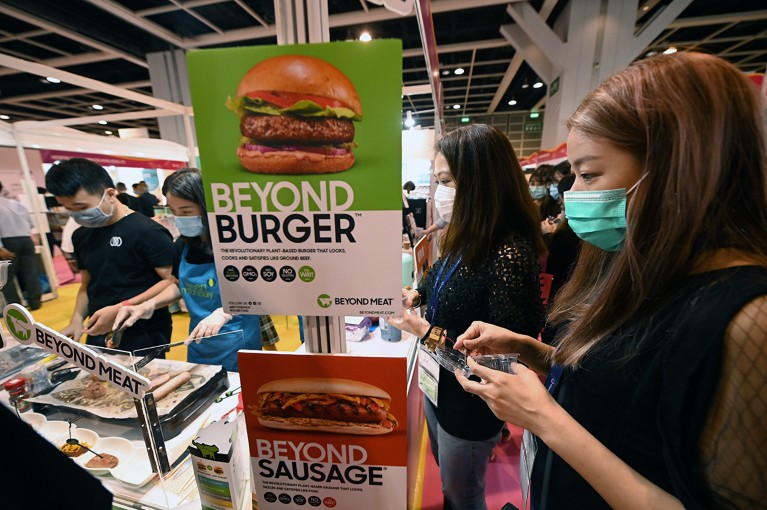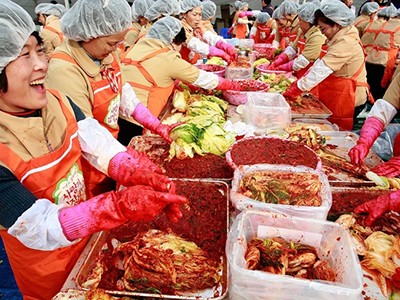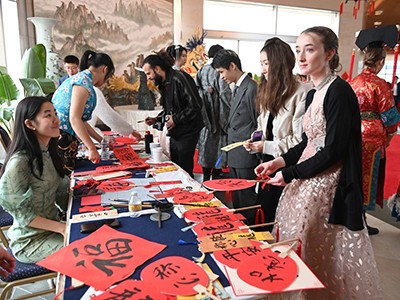In August, bioengineers, chemists, plant biologists and food scientists based in China and Singapore came together in a closed hybrid conference with one ambitious goal: to unlock the massive economic and food-security promise of plant-based and cultivated meat. As biochemist Huang Dejian at the National University of Singapore highlighted at the start, Asian scientists are poised to play a crucial part. Just as researchers in the region were instrumental in putting the world on a path to affordable clean energy, they can do so again — for sustainable foods.
Meat production is long overdue for an upgrade. Conventional methods are inefficient: feeding up to 100 calories1 of crops to a cow produces just one calorie of beef. They’re also land-intensive. Three-quarters of all agricultural land — an area twice the size of China and India combined — is used to grow feed for chickens and pigs or to graze cows and other livestock, fuelling deforestation and depleting water resources. Foods sourced from animals account for one-fifth of global annual greenhouse-gas emissions2, releasing more methane than does oil and gas production.
Are you what you eat? Biggest-ever catalogue of food microbes finds out
If nothing changes, our food system is on a collision course with planetary limits. Meat production is projected to increase by more than 50% by 2050 compared with 2012 levels, driven by a growing global population that is becoming more prosperous. Such pressures are especially acute in Asia, which accounts for about half of the global growth in protein consumption so far this century.
Alternatives to conventional animal proteins can change that trajectory. Life-cycle assessments3 show that by harnessing protein directly from its biological source, rather than feeding crops to animals, producers can slash meat’s greenhouse-gas emissions by up to 98%. Such alternative proteins can also reduce the use of agricultural land by up to 96% and that of water by 99%, boosting food resilience and transforming scarcity into abundance.
The potential economic rewards are enormous, too. By 2050, the alternative-protein sector could generate some US$700 billion annually in economic growth4. But where those gains will go is still up for grabs.
Pulling from a proven playbook, China and other Asian countries are accelerating alternative-protein development through public investments and regional scientific collaborations. Here we highlight how, and outline priorities and challenges for such research.
Sustainable alternatives
Harnessing the power of sustainable proteins is both a scientific and a commercial challenge.
Plant-based meat production involves using plant biology, chemistry, food science and biotechnology to replicate the taste and texture of conventional meat. Yet studies show that existing products fall short5 of most consumers’ expectations on palatability and come at a premium of more than 70% in major markets6 — a fatal combination.
Producing cultivated meat involves using tissue engineering to grow animal protein without the need for a live animal. It has fewer flavour hurdles than plant-based meat products have and has come a long way since the first cultivated burger was served in 2013, at a cost of $330,000. But scientists are still grappling with technical knowledge gaps. These include a shortage of best practices for growing, duplicating and maturing cells in ways that are conducive to large-scale commercialization. Cell lines for cultivated meat7 have underdeveloped supply chains. There is also a lack of clarity around how they should be obtained and safety tested in various jurisdictions.
As a result, cultivated meat is currently produced in vanishingly small volumes and the industry is unable to leverage economies of scale. To bring down prices, large bioreactors are needed, which are capable of growing cells in volumes of 50,000 litres or more.

Alternative proteins remain challenging to produce on commercial scales.Credit: Peter Parks/AFP via Getty
In total, the protein transition will require building or repurposing about 12,000 plant-based and cultivated meat factories, each capable of producing 30,000 tonnes of meat a year. And decarbonizing Asia’s protein supply will require reaching peak industrial animal production in the next six years, while ramping up alternatives to conventional meat, dairy and eggs8. Alternative meat and seafood products currently account for less than 1% of the region’s protein supply. By 2060, alternative proteins must account for more than 50%.
These are precisely the kinds of hurdle that Asian innovation hubs have the ability and incentives to overcome, as demonstrated by their progress in scaling up the production of renewable energy and batteries for electric vehicles over the past two decades9. That’s why those watching the protein sector took note in January 2022 when China announced its current Five-Year Agricultural Plan, featuring a new section dedicated to ‘future foods’ manufacturing. In a Chinese context, such documents are blueprints of what’s to come. And China is not the only country in the region pushing forwards in this space.
Asian nations taking the lead
One of the earliest countries to invest in alternative-protein research and development (R&D) is Singapore, an import-reliant city-state that has watched with concern as avian influenza, African swine fever and climate disruptions have made the global meat supply unstable. By bringing together forward-thinking policymakers, regulators and scientists, it became the first nation to achieve commercial sales of cultivated meat in December 2020, more than two years before the United States did.
Less than one year later, it issued its first processing licence to a cultivated-meat manufacturer. And, on 5 September, the philanthropic organization Bezos Earth Fund selected Singapore as the home of its new $30 million Bezos Centre for Sustainable Protein, the first facility of its kind in Asia. Thanks to its business-friendly approach to innovative foods, the city-state is the headquarters of nearly one-quarter10 of all alternative-protein start-up companies in the Asia-Pacific region, punching far above its weight.
Data on SDGs are riddled with gaps. Citizens can help
Other Asian countries are poised to follow Singapore’s lead. In February 2023, Japanese Prime Minister Fumio Kishida hailed cellular agriculture as an important part of “realizing a sustainable food supply”. His government has since awarded tens of millions of dollars in funding to alternative-protein companies, as part of a larger food-sustainability moonshot.
In March, Malaysia’s then-deputy minister of science, technology and innovation, Arthur Joseph Kurup, suggested that the cultivated-meat sector “promises to create job opportunities and revenue while addressing national challenges such as food security, health management and climate change”. Start-up firm Cell AgriTech in Kulim has since received government grants to scale up its operations and announced plans to construct a manufacturing facility capable of producing 3,000 tonnes of cultivated meat annually.
And this May, South Korea designated a regulation-free zone that will empower domestic cultivated-meat start-up companies — some of which have received multimillion-dollar government grants — to start producing cell banks and manufacturing infrastructure while regulators review the first product approvals. Commercial sales could begin by 2025.
Importantly, China has moved quickly to deliver on President Xi Jinping’s 2023 call for science and technology to be “the wings” of agricultural modernization. In August, Nanjing-based start-up firm Joes Future Food served cultivated pork to local government officials to demonstrate its progress after receiving public funding for developing industrial-scale manufacturing methods. Similar support is being dispersed to alternative-protein stakeholders across the country through provincial and municipal initiatives, which follow the guidance of national five-year plans.
At China’s National People’s Congress in March, officials put forward several initiatives to accelerate alternative-protein development and distribution. Xiong Tao, congress deputy and chair at Hubei Anqi Biological Group in Yichang called for increased R&D funding, expedited regulatory-approval processes and stronger intellectual-property protections for future-food producers. He also outlined the need for national education and promotional programmes that can expand China’s scientific talent pipeline, to ensure that the sector has sufficient people power to scale up quickly. His proposal is now under review at the Ministry of Agriculture and Rural Affairs.

Efforts are under way to improve the taste and texture of cultivated meat products, such as this cultivated ‘chicken breast’.Credit: CellX
Economics is one driving force behind China’s interest in alternative proteins, but there are geopolitical benefits, too. As local consumers’ purchasing power and per-capita meat consumption have risen, Chinese meat producers have resorted to importing hundreds of millions of tonnes of soya beans and maize (corn) to fulfil their domestic animal-feed needs. Last year, to keep pace with surging demand, China also brought in at least nine million tonnes of meat from abroad, making it the world’s largest meat importer.
But a core tenet of President Xi’s approach to food security, articulated with increased frequency in the past few years, is that the Chinese people’s metaphorical “rice bowls” must always be “filled mainly with Chinese grain” — a goal hindered by a heavy dependence on international imports. By mastering the art of making protein from plants, microorganisms and cultivated cells, China can produce a lot more of it and bolster self-sufficiency by reducing reliance on animal feed and meat from abroad.
Leverage regional collaborations
Now that Asia’s political leaders have embraced the ‘what’ and ‘why’ of alternative proteins, scientists have been tasked with answering the ‘how’.
Between 2020 and 2023, researchers in the Asia-Pacific region published more than 400 papers10 aimed at closing alternative-protein knowledge gaps — nearly twice the US output in the same period. In total, Singapore has invested 24 times as much public funding11 as a percentage of its gross domestic product into protein innovation as the United States has.
Lab-grown meat: the science of turning cells into steaks and nuggets
Government funding initiatives are accelerating such research. For example, the Singapore Food Story, a $230 million R&D programme10, is tackling the gap in accessibility to cell lines for cultivated meat by aiding research collaborations between industry and academia. China’s National Key Research and Development Program has funded projects to reduce the costs of proteins and enhance the textural profile of cultivated pork.
At last month’s China–Singapore conference, scientists exchanged insights on techniques to scale up alternative-meat industrialization. These included layering flavour pockets from cultivated animal cells into plant-based protein sheets to make hybrid products; using yeast protein in alternative-meat formulations; and designing innovative bioreactors that reduce cultivated-meat production costs by leveraging computer simulations to test for optimal growth conditions.
Although some of these breakthroughs have not yet been published, the intention is for much of this publicly funded work to be released open access in local or international journals, to provide a sturdier foundation for regional start-ups to build on. Using government funds to resolve foundational challenges that have bedevilled such firms lifts the burden for them to do costly and duplicative R&D in-house. Each breakthrough also moves the alternative-protein sector one small step closer to a commercial-viability tipping point.
Those watching such progress from outside Asia have a growing sense that the window of global food-technology opportunity won’t remain open forever. In 2023, the US Center for Strategic and International Studies — the country’s top national security think tank — argued in a seminal report12 that the government should prioritize alternative proteins as a crucial national industry, on a par with pharmaceuticals, clean-energy technology and advanced chips for artificial intelligence. Another report13, by the US National Security Commission on Emerging Biotechnology, concluded that China is well positioned to capitalize on agricultural innovations, owing to its considerable investments in R&D and production capacity in existing food sectors.
Success is not guaranteed
Although Asian scientists are leaning in on ‘future foods’, several government levers remain to be pulled.
Public R&D funding has risen since 2020 but lags behind what is needed. In a Global Innovation Needs Assessment on protein diversity14, ClimateWorks Foundation in San Francisco, California, and the UK Foreign, Commonwealth and Development Office in London concluded that unlocking the benefits of alternative proteins would require governments to invest at least $10.1 billion annually — $4.4 billion for global R&D and $5.7 billion to help the industry to scale up. Last year, total global public investments were less than 4% of that11.
Why US–China relations are too important to be left to politicians
But if China leverages the tools at its disposal, it would be the largest accelerant the sector could hope for. The nation already allocates more public funding to agricultural R&D than does any other country, and invests twice that of the United States, which occupied the top spot until the early 2000s. China also now publishes the most academic papers on the topic and filed for almost four times as many agricultural patents as any other country over the past five years. Between 2003 and 2013, government support helped to increase Chinese grain, milk, meat and aquaculture production by between 20% and 50% each.
Governments would also benefit from creating national task forces for alternative-protein development. Rather than relying on food and drug administrations, government entities can connect siloed scientific disciplines and industry stakeholders, prioritize research areas and coordinate on harmonizing international regulations.
Asian innovation hubs have the capacity, workforce and incentives to achieve taste parity for plant-based meat, resolve technical challenges and take cultivated meat from test kitchens to supermarkets around the world. Hard to imagine? Call a friend in Singapore. It’s been on shelves there since May.






